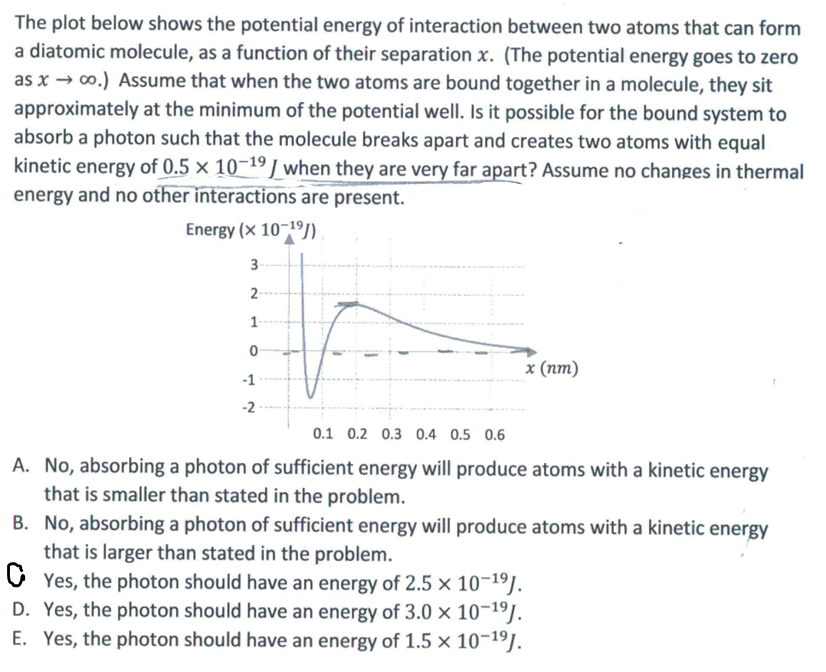The plot below shows the potential energy of interaction between two atoms that can form a diatomic molecule, as a function of their separation x. (The potential energy goes to zero as x→ ∞o.) Assume that when the two atoms are bound together in a molecule, they sit approximately at the minimum of the potential well. Is it possible for the bound system to absorb a photon such that the molecule breaks apart and creates two atoms with equal kinetic energy of 0.5 x 10-19 / when they are very far apart? Assume no changes in thermal energy and no other interactions are present. Energy (× 10-1⁹) 3- 2- -1 -2 x (nm) 0.1 0.2 0.3 0.4 0.5 0.6 A. No, absorbing a photon of sufficient energy will produce atoms with a kinetic energy
The plot below shows the potential energy of interaction between two atoms that can form a diatomic molecule, as a function of their separation x. (The potential energy goes to zero as x→ ∞o.) Assume that when the two atoms are bound together in a molecule, they sit approximately at the minimum of the potential well. Is it possible for the bound system to absorb a photon such that the molecule breaks apart and creates two atoms with equal kinetic energy of 0.5 x 10-19 / when they are very far apart? Assume no changes in thermal energy and no other interactions are present. Energy (× 10-1⁹) 3- 2- -1 -2 x (nm) 0.1 0.2 0.3 0.4 0.5 0.6 A. No, absorbing a photon of sufficient energy will produce atoms with a kinetic energy
Related questions
Question
Please asap

Transcribed Image Text:The plot below shows the potential energy of interaction between two atoms that can form
a diatomic molecule, as a function of their separation x. (The potential energy goes to zero
as x→ ∞o.) Assume that when the two atoms are bound together in a molecule, they sit
approximately at the minimum of the potential well. Is it possible for the bound system to
absorb a photon such that the molecule breaks apart and creates two atoms with equal
kinetic energy of 0.5 x 10-19 / when they are very far apart? Assume no changes in thermal
energy and no other interactions are present.
Energy (× 10-1⁹)
3-
2-
-1
-2
x (nm)
0.1 0.2 0.3 0.4 0.5 0.6
A. No, absorbing a photon of sufficient energy will produce atoms with a kinetic energy
that is smaller than stated in the problem.
B. No, absorbing a photon of sufficient energy will produce atoms with a kinetic energy
that is larger than stated in the problem.
CYes, the photon should have an energy of 2.5 × 10-1⁹J.
D. Yes, the photon should have an energy of 3.0 × 10-¹⁹J.
E. Yes, the photon should have an energy of 1.5 x 10-¹⁹J.
Expert Solution
This question has been solved!
Explore an expertly crafted, step-by-step solution for a thorough understanding of key concepts.
This is a popular solution!
Trending now
This is a popular solution!
Step by step
Solved in 3 steps with 2 images
